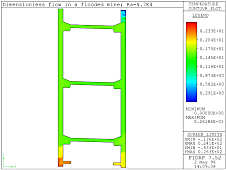Projects
 Hydrodynamic transport mechanisms in flooded underground mines
Hydrodynamic transport mechanisms in flooded underground mines
Reduction of Pollutants by Prediction and Control
Introduction
Mining activities represent a potential risk and, generally, the substance flows in the mines’ surroundings are affected negatively. Due to mining activities, the infiltration water mobilises easily soluble phases within the drained host rock and the mine galleries being open to the atmospheric oxygen, resulting in highly contaminated mine water. Particularly in ecologically sensitive systems, these processes in the mines’ surroundings can cause irreversible damages to both, the bio- and antroposphere.
In the case that a mine cannot be operated profitably any longer and depending on the mine's geometry, it will be locked or flooded by stopping the mine water pumps. Due to experiences, the hydrodynamic conditions in the flooded mine will either lead to a mixing or to a layer of uncontaminated groundwater above the contaminated mine water. This seems to be independent of whether the mine is flooded controlled or uncontrolled.
After the mine being flooded, the drainage water can have one of the following characteristics:
- uncontaminated
- highly contaminated at the beginning, thereafter fast dropping pollutant concentrations
- highly contaminated at the beginning, thereafter slowly dropping pollutant concentrations
- constantly highly contaminated
Causally, the following factors are responsible for this behaviour:
- Geochemical composition of the host rock and the mined ore
- Chemical composition of the infiltration water flowing into the mine
- Chemical composition of dredge materials
- Tectonic conditions of the host rocks (fracturing, porosity)
- Type of the mining and the production
- Hydrodynamic conditions
- Geometry and volume of the mined space
- Duration of the mining operation
Quite obviously, the factors mentioned first have a crucial influence on the substance discharge from the mine, whereas the two latter factors are at first fewer obvious.
Work Target
In order to eliminate damages to the hydrosphere caused by the mining operations, and in order to operate water treatment plants, large financial means are to be applied. Conceptual models, by which the hydrodynamic conditions and the resulting pollutant discharge could be predicted, thus represent an important contribution to the ecology and economics of existing and future mining operations.
As already known, the type of the mining propulsion has substantial effects on the later chemical composition of the drainage waters. However, there are no comprehensive scientific investigations yet, to what extent pit geometry and flow control can affect the pollutant potential and the substance transfer within the mine and its surroundings. This project will close this gap and will develop a model for underground ore mines, by with it will be possible to
- predict the pollutant discharge and the hydrodynamic regime from an underground mine that has to be flooded as a function of mine geometry, and
- predict the reduction potential of the pollutant discharge by the use of underground barriers
In addition, stochastic investigations as well as numerical methods (the latter only in parts), tracer tests, and in-situ measurements are necessary.
The questions to be solved are therefore:
- Which methods and boundary conditions can be used to trustworthy predict the pollutant discharge from a to be flooded underground mine?
- Which criteria for the evaluation of the pollutant potential are applicable?
In the reverse, based on the results of the project, underground mines can be planned in such a way that after the mine’s flooding ecological pollutions and economic burdens are lowered to a minimum.
Methods
In order to completely model the hydrodynamic regime in a flooded or to be flooded underground mine by numerical methods, and to get the optimal use out of the boundary conditions, it would be necessary to collect a huge number of parameters. However, in most cases, these cannot be obtained in sufficient accuracy. Over and above, analytic, numeric and experimental investigations at simple flow models show, that, on spacious examination, chaotic conditions may easily arise, therefore the flow conditions being no longer predictable.
Therefore, stochastic and empirical methods as well as tracer methods are to be applied instead of numeric methods.
In order to gain the database for these investigations, the following data is to be collected in numerous underground mines:
- Physico-chemical composition of the mine water at different localities and at different times
- Depths dependent physico-chemical in-situ measurements in flooded shafts
- Flow regime by means of tracer tests
- Mine plan and -geometry
- geology of surroundings (geology, mineralogy, geochemistry, hydrogeology)
By means of empirical comparisons and stochastic calculations of the aforementioned parameters, the different underground mines, regarding their pollutant potential and mine geometry, are to be classified and the results to be verified.
Results
From the results of the empirical and stochastic analyses predictions concerning the following points can be attained:
- Optimal lay out of an underground mine, in order to keep the pollutant discharge insignificant after the end of mine flooding
- Minimisation of the pollutant discharge by the installation of barriers
- Order of magnitude of the pollutant discharge after the end of mine flooding
- Type of the mixing (convective or diffusiv) of the mine water within the underground mine after the end of mine flooding
- Period, after which a significant decrease of the pollutant discharge is to be achieved
Thus, the results of the project will contribute to reduce the ecological pollutions and economic burdens of an underground mine to a minimum by correct mine planning or the installation of technical or chemical barriers.




